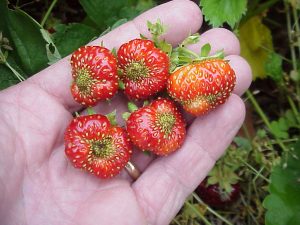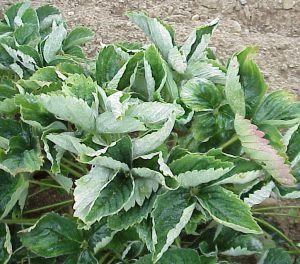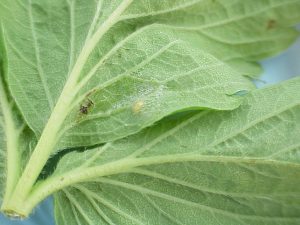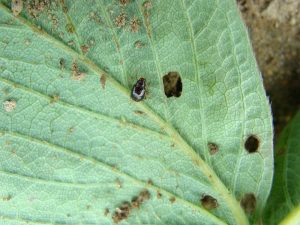Strawberry IPM Newsletter No. 3 — May 31, 2024
TARNISHED PLANT BUG THREATENS STRAWBERRY BLOSSOMS
Botrytis Fruit Rot Risk Elevated Due to Recent Rains
Situation: Warmer temperatures have advanced both plant and insect development this week. Green fruit are showing on early strawberry varieties in southern Maine, while late varieties are just coming into bloom. Tarnished plant bug nymphs and spider mite populations are increasing in most fields we visited this week. Recent rains will increase the likelihood of gray mold infections during bloom. Fields continue look very good.

Tarnished Plant Bugs: Nymphs are now being found in most strawberry fields we have scouted. Six out of the eight locations we visited were over the control threshold of 4 or more flower clusters infested with nymphs per 30 sampled. Growers should scout their fields for tarnished plant bug nymphs now. The early stages (instars) of the nymphs are very small, only about 1/16”, and light yellow-green in color. They are very active and run quickly when disturbed; they cannot fly until they are mature. Left uncontrolled, the nymphs and adults will feed on the blossoms and developing fruit and cause “cat-facing”, where much of the fruit remains undeveloped. Insecticide options for tarnished plant bugs include malathion, Assail®, Brigade®, Bifenture®, Dibrom®, Danitol®, Closer® and PyGanic®.
Strawberry Bud Weevil or “clipper”: Early fields in southern Maine are now beyond the bloom-fruit development stage where clipper can cause significant damage. However, later blooming fields should still be monitored for clipper injury until most of the flower buds have opened. We have found some low levels of clipper injury (clipped flower buds) this week, but not over the control threshold.
Two-Spotted Spider Mites: Populations have been increasing in some fields this week. Two locations were over the control threshold of 25% of leaves sampled being infested with mites, and controls were recommended. We expect populations to increase with warmer, drier weather ahead. Continue to scout for mites regularly. Chemical control options for two-spotted spider mites include Acramite®, Portal®, Nealta® Savey®, Zeal®, Vendex®, Oberon®, Brigade®, Danitol®.
Spittlebugs: Spittlebugs were found on some of the weeds around the strawberry fields this week. They may soon start to show up on the strawberry plants. The frothy spittle masses appear on the leaf stems (petioles), just below the leaflets. These typically start showing up around bloom. Although these spittlebugs don’t pose a significant threat to the plants, the frothy spittle they cover themselves with creates an annoyance for pickers. Adult spittlebugs are about ¼ inch long and bright green when they first emerge, but later turn dull yellow or brown. Spittlebugs overwinter as eggs and the nymphs emerge in late May. You should start to scout for spittlebugs when the plants are at about 10% bloom. Randomly inspect five one square foot areas per field every week. Spread the leaves and inspect the leaf bases, leaf stems, and flower stems looking for the white, frothy spittle masses. Spittlebugs tend to be a greater problem in weedy fields. Pesticides currently registered for spittlebug control include Provado®, Danitol® and Brigade®.
Strawberry Rootworm (not root weevil): Strawberry rootworm adults and feeding injury have been found on strawberry leaves in some fields this spring. The adult stage of this insect is a small (1/8”) dark brown beetle. The beetles feed on strawberry leaves during the spring and late summer, causing numerous small holes in the leaves. The adults in fields now will soon lay eggs. The larvae are small grubs that feed on the roots of strawberry plants, causing them to be stunted and weak. If these beetles and/or feeding injury is prevalent in a field, a treatment is recommended. Sevin 50WP® is registered for control of this pest. Sprays can be timed to also control strawberry bud weevil. Strawberry rootworm should not be confused with root weevil, a larger insect that causes much more serious damage when present in a field.
- Spittlebug, Photo by David Handley
- Strawberry Rootworm Beetle; photo by David Handley
Diseases: Fungicide sprays are recommended to protect strawberry fruit against gray mold during bloom, especially when conditions have been damp. Sprays should begin at about 5% bloom with follow up applications at full bloom and petal fall. The later spray can be skipped if conditions remain dry following the bloom spray. Fungicide choices for control of gray mold in strawberries include: Topsin M® + captan, Elevate®, Captevate®, Switch®, Scala® and Pristine®. Remember to alternate fungicides with different modes of action for resistance management purposes.

Powdery Mildew: We found a couple of fields with low levels of powdery mildew on foliage this week. The symptoms of this disease include upward curling of the leaves, purple or reddish blotches on the petioles, and the white, powdery fungus on the undersides of the leaves. These infections will weaken plants and can reduce yield the following year. When selecting a fungicide for Botrytis fruit rot, use a material that is also effective against powdery mildew such as Captan, Topsin-M®, Pristine®, or Cabrio®, or tank mix the gray mold product with a good powdery mildew product such as Quintec® or Procure®.
Leaf Spot continues to be found on susceptible varieties this week, but mostly on older foliage. The cool, damp weather has encouraged this problem. Fungicides now being applied for gray mold, including Captan, Luna Sensation®, Mervion® and Pristine® will also provide control of leaf spot.
Grass control in strawberry fields: Controlling perennial grasses in strawberry beds can be challenging. Poast®, Select 2EC® and Selectmax® 0.97EC are registered to control emerged grasses in strawberries. Often more than one application is needed to obtain satisfactory control. All of these products require the addition of a crop oil concentrate to the spray. It is important to note that these products can cause significant injury to strawberry plants if they are applied on hot, humid days, or if high temperatures occur within one or two days of application. Poast® should not be applied within 7 days of harvest. Select® and Selectmax® should not be applied within 4 days of harvest. Follow all product label instructions.
Spring Growers’ Twilight Meeting
The Maine Vegetable & Small Fruit Growers Association will be having a Spring Twilight Meeting on Thursday, June 13, at 5:30 pm at Snell’s Family Farm, 1000 River Road in Buxton. John and Roberta Snell grow a wide variety of vegetables, apples and berries for their stand and CSA, and their daughter Carolyn runs a cut flower business from the farm.
2024-2025 New England Small Fruit Management Guides: A printed version of the new edition of the Guide is now available through our office. The cost of the Guide is $25, including shipping. You can request a copy by sending a check made out to “UMaine Cooperative Extension” to our Highmoor Farm address below. Members of the Maine Vegetable & Small Fruit Growers Association will receive a copy as a benefit of membership. The latest edition of the Guide is also available free online at 2024-2025 New England Small Fruit Management Guides.
You can also get quick access to this information through the UMaine Highmoor Farm news blog or the UMaine Pest Management web page.
Sincerely,
David T. Handley
Vegetable & Small Fruit Specialist
Highmoor Farm
P.O. Box 179
52 U.S. Route 202
Monmouth, ME 04259
207.933.2100
UMaine Extension Diagnostic Research Lab
Pest Management Unit
17 Godfrey Drive
Orono, ME 04473
1.800.287.0279
Where brand names or company names are used, it is for the reader’s information. No endorsement is implied nor is any discrimination intended against other products with similar ingredients. Always consult product labels for rates, application instructions and safety precautions. Users of these products assume all associated risks.
In complying with the letter and spirit of applicable laws and pursuing its own goals of diversity, the University of Maine System does not discriminate on the grounds of race, color, religion, sex, sexual orientation, transgender status, gender, gender identity or expression, ethnicity, national origin, citizenship status, familial status, ancestry, age, disability physical or mental, genetic information, or veterans or military status in employment, education, and all other programs and activities. The University provides reasonable accommodations to qualified individuals with disabilities upon request. The following person has been designated to handle inquiries regarding non-discrimination policies: Director of Equal Opportunity, 5713 Chadbourne Hall, Room 412, University of Maine, Orono, ME 04469-5713, 207.581.1226, TTY 711 (Maine Relay System).


